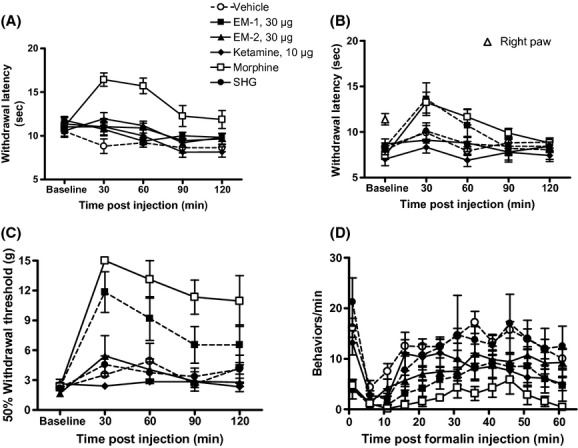Figure 1.

Effect of intrathecal injection of drugs in pain-related behaviors in rats over time. The highest doses of drugs injected alone used in the study are shown. (A) Acute/heat: Following baseline latency determination, rats were i.t. injected with either vehicle or drug in a volume of 5 μL. Rats were tested once every 30 min up to 120 min post injection. The latencies of the left and right hind paws were combined. (□) Dose of morphine = 10 μg. (●) Dose of SHG = 1 μg. (B) CCI/heat: Following baseline latency measurement in rats with a CCI, either drug or vehicle was i.t. injected and rats were tested once every 30 min up to 120 min post injection. The baseline withdrawal latency of the contralateral right hind paw (△) was not significantly different from the latency of the left hind paw prior to CCI. (□) Dose of morphine = 3 μg. (●) Dose of SHG = 0.3 μg. (C) CCI/tactile: Following baseline threshold determination, rats were i.t. injected with either drug or vehicle and tested once every 30 min up to 120 min post injection. (□) Dose of morphine = 3 μg. (●) Dose of SHG = 0.3 μg. (D) Formalin test: Either drug or vehicle was i.t. injected, followed 10 min later by 5% formalin injected into the left hind paw. The number of pain-related behaviors per minute was counted every 5 min until 61 min post formalin injection. (□) Dose of morphine = 3 μg. (●) Dose of SHG = 0.3 μg. Data are mean ± SEM. n = 6–7 rats per group.
